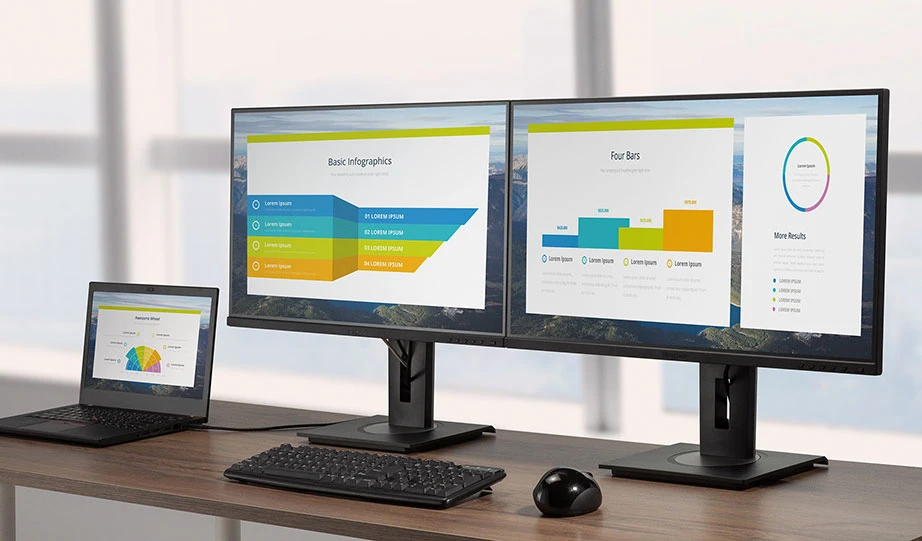The USB-Cable, formally known as USB Type-C was designed in 2014 and it was available around the same time as USB 3.1. USB type-C has rapidly grown in popularity, particularly given its presence as a one-cable solution. As a connector with 24 pins, 12 on each side, USB-C was developed with an eye towards increased transfer speed. The first USB came out in 1996. USB 3.2 is undergoing industry adoption via USB-C (or USB Type-C) connectors which includes a wide range of use cases, like dedicated USB-C monitors. It’s been a rapid journey from 1.0 to the newest iterations for USB.
A USB-C monitor is a highly versatile, super-fast USB cable to connect to the device. As devices move towards a universal connection type, it is useful to have the broad functionality of a USB-C connection on display, with 2-way data transfer, charging and multiple other advantages. USB-C connectors may be the future of monitors and other devices. The USB version number primarily refers to the speed at which USB-housed data can transfer. USB 1.0, at full speed, can transfer data at 1.5 Megabytes per second, and SuperSpeed USB 3.2 can transfer data at a rate of 2.5 Gigabytes per second. Complete with integration in commercially available computers, USB-C monitors or USB Type-C Monitors have become a subsection unto themselves.
Reduce Cable Complexity
The cluster and complexity are reduced by using Type C cable. The problem arises when different monitors necessitate separate connections. Rooting through a box of miscellaneous cables can be laborious and frustrating. USB-C reduces all this cable clutter to a lightweight cord that transfers audio, video, data, and power, leaving workspaces free of distractions and offering plug-and-play connectivity for workers.
Make power supply simple
The game-changing convenience of USB-C that it supports much higher power transmission than earlier versions of USB. The first USB iterations only offered 2.5W and 5V, which was useful, but just not enough for anything other than small devices. USB-C allows up to 100W and 20V, which is more than enough for large displays and many other devices.
Easy to connect
USB-A connectors encounter the difficulty of plugging. Few USB-A connectors have the USB symbol on the top side, indicating the correct orientation. Forcing the incorrect entry of the ends may result in hardware damage. USB-C’s full rotational symmetry solves all these issues. Both ends of a USB-C are the same, plugging it in easily and getting to work seamlessly.
Provide In-Built Audio
One of the big shortfalls of traditional video connections is the need for a separate audio cable, which usually confuses the user. USB-C offers an audio Accessory Mode, which allows both digital and analogue audio signals to pass through the connection. Therefore, separate wire and connections are not required.
Carry More Data
The USB version number gives the data capacity of USB cables. Version 1.0 in 1996 offered a maximum of 12Mbits/s at full speed. The latest revision supported on USB Type-A and Type-B connectors is USB 3.1, which provides 10Gbits/s. 3.2 is capable of 20Gbits/s, while USB4 offers an impressive 40Gbits/s. USB4 is not yet widely supported, but this is the future and only USB-C supports it. This data rate is necessary for the highest resolution displays of the future and will easily drive 8k at 60Hz.
Become Future-Proof
As the newer technologies emerge, the older ones fade out. Though USB-C was originally specified in 2014, only in the last couple of years have the manufacturers widely adopted it. USB-C Monitors indicate the future direction while considering the past, though the cables offer significant backward compatibility.
USB-C is the future not only for the monitors, though. Many laptops, like Apple’s latest MacBooks and the newest Chromebooks, are now being sold with only USB-C ports. It is now the perfect time to future-proof your set-up and not be left behind with tangled cables and plug-in hassles.
Range of Type-C Monitors by ViewSonic
- Essential Series: Office and Home Usage, Neat & Clean working/study desk
- Portable Series: Mobile working station—Lightweight to carry for presentation. Easy to connect via mobile phone
- Ergonomic Series: Multitasking Workspace – comfortable, healthy workspace within the ergonomic design and daisy chain
- Creative Series: Maximizing digital canvas via daisy chain and lightning speed
- Touch Series: Designed to seamlessly integrate into workflow. With a compact form factor and clean design for easy integration, they are well-suited for point-of-sale, point-of-information, signage, and hospitality applications
Check the whole range here!
The latest development in the line of USB connectors is changing the digital cabling world, making home and office spaces clutter-free, more productive, and future-facing. With just one cable, no longer need to worry about cumbersome power cords, slow data transfer speeds, or not having the right plug for your presentation.
Articel Contributed By Mr. Sanjoy Bhattacharya, Director Sales & Marketing, IT Business, ViewSonic India.







